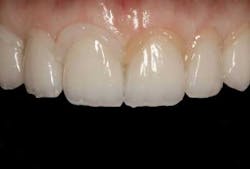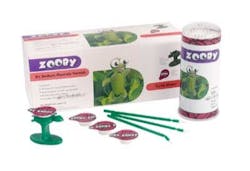Comparison of the cytotoxicity of calcium hydroxide and tricalcium phosphate
Figure 3.2 – Calcium hydroxide powder pure concentration effects on Vero cells at 24th hour (x100 microscopic view)
As result of such assessments, no toxic impact has been observed in the pure concentration of tricalcium phosphate. No toxic impact has been observed in other concentrations of both substances, and it has been observed that the biocompatibility of calcium hydroxide was better than tricalcium phosphate.DiscussionCalcium hydroxide is widely being used in endodontic treatment. It is being used as in-channel dressing material and also in apexification treatment.Various researchers argue that different materials should be used for apexification treatment.4,5 Roberts and Brilliant6 have set out in their research that tricalcium phosphate has stimulated the apical barrier and achieved equal success with calcium hydroxide. Caviello et al.7 have set out that tricalcium phosphate has slowly been resorbed and changed place with calcified tissue.Tricalcium phosphate is efficiently being used in furcation perforations due to its biocompatibility and low inflammatory potential.8Beta-tricalcium phosphate has been used with success as an alternative to calcium hydroxide apexification in order to form an apical barrier in immature permanent teeth. Therefore, there are many studies that support beta-tricalcium phosphate use.9 However, the cost of beta-tricalcium phosphate burdens its widespread use.10In 1966, Frank has declared that calcium hydroxide apexification is a reliable and acceptable treatment approach. Frank has advised the application of calcium hydroxide and CMCP mixture to root channel.11,12,13Calcium hydroxide forms an apical barrier and also contributes to the treatment of periapical tissues.The different chemical structure of calcium hydroxide and tricalcium phosphate gives the idea that their toxic impacts on the tissues may be different from each other’s.In our study, we aimed to research the toxic impacts of calcium hydroxide and tricalcium phosphate which have been used in practice, as in vitro.Wennberg14 has used the milipore filter technique on rat fibroblast cells for the purpose of determining biological features of four different channel filling paste as in vitro.Yesilsoy and Feigal15 have examined the cytotoxicity of channel filling materials with milipore filter technique in rat fibroblast cells and in human dental pulp cells.Kawahara et al.16 have detected cytotoxic impacts of materials used in dentistry in primary chicken embryo, fibroblast, and rat fibroblast cells microscopically and via viable cell count.In our study, Vero cell culture, which has been produced with DMEM, contained 10% FCS. The methodology chosen by Aydın et al.17 has been used as testing method after the same has been modified. Calcium hydroxide and tricalcium phosphate have been used in different ways as powder and paste for the purpose of checking the cytotoxicity of the same. Morphology changes in cells, rounding and grouping of cells, have been taken into account as criteria during toxicity assessment.ConclusionWhen cytotoxic impacts of calcium hydroxide and tricalcium phosphate have been examined, no toxic impact has been observed in the pure concentration of calcium hydroxide while toxic impact has been observed in pure concentration of tricalcium phosphate. No toxic impact has been observed in other concentrations of both substances, and it has been observed that the biocompatibility of calcium hydroxide was better than tricalcium phosphate.











